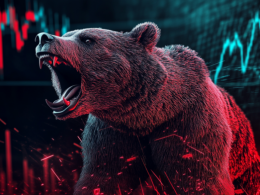by Jeff Shen, PhD, Co-CIO of Active Equities, Co-Head of Systematic Active Equity (SAE), Blackrock
The global coronavirus pandemic is testing all aspects of everyday life. Jeff Shen discusses how his team are using human and machine-mined insights to assess the landscape and look ahead.
These are unusual times, to say the least. Few in the financial industry have seen a global pandemic and widespread economic shutdown, and we must approach our outlooks with a dose of humility.
Our Systematic Active Equity team is bringing together human insight and robust quantitative tools and techniques in seeking to illuminate some of the dark spots in the outlook.
Alternative data has been an area of intense focus for us over the past decade. And today, satellite images, foot traffic and transaction data are giving us a better read on the economy amid widespread global closures and re-openings. At the same time, the natural language processing of news flow, retail blogs and broker reports afford us a deeper understanding of investor sentiment and market reactions to policy responses. We combine these modern techniques with our investors’ deep understanding of the market from both a macroeconomic and finance perspective to better understand investment risk and opportunity.
To that end, we have identified three areas for investor consideration as the stock market has moved from the earlier phase of free-fall to the current phase of bottom-seeking and increased dispersion:
1. What can we learn from China?
Slowly but surely, China’s economy is on the path to recovery. The alternative data we track (satellite images, traffic congestion and transaction data) offers some hints as to how the recovery may play out in other parts of the world.
First, China’s recovery seems to be staggered and gradual. We see many differences across cities and provinces with a slower recovery in the more connected cosmopolitan areas and faster in the periphery. We think the recovery around the globe will also be uneven, with large country or geographic differences. This could imply country as a unit of analysis may be more important for investors going forward.
Second, we note China’s supply recovery has been faster (factories have re-opened) while the demand recovery (consumer activity) has been slow. It’s easier to ask people to go back to work but much harder for people to feel confident enough to book their next cruise vacation.
2. How long will current patterns persist?
While the overall market has been extremely volatile, we find the cross-sectional trends in the equity markets have not only been persistent, but even perpetuated: Momentum outperforming value, technology outperforming energy, the U.S. outperforming the rest of the world, and large cap outperforming small cap. These have been the prevailing trends over the past few years, and the current market volatility has not reversed but instead accelerated them. This is reminiscent of the late 1990s dot-com era when the winners in the market were concentrated and persistent ― until the pattern went to the extreme. We don’t seem to be there yet, but this is a significant source of risk going forward.
3. How much deleveraging ahead?
In the market free-fall phase that began in February, there was really no place for investors to hide. Risky assets of all sorts were punished, and the market drop was fast and furious. We then observed sharp hedge fund deleveraging in the middle of March similar in scale to that seen during the Global Financial Crisis and Lehman Brothers collapse. This “technical deleveraging” seemed to be partially over with some notes of market stability in late March and early April, and the popular hedge fund positions recovered a portion of their losses. This is an area we continue to monitor, as further hedge fund deleveraging and changing positions can feed back into broader risk-off sentiment.
What’s to come?
The only thing we can say with some certainty is change. The bursting of the dot-com bubble foretold a 10-year bear market for the technology sector. And 10 years after the global financial crisis, the banking sector hadn’t fully recovered.
We expect profound implications and changes to geopolitics, technology and capitalism after this crisis. The bottom-seeking phase will eventually transition into recovery mode, but the world is not likely to return to where it was in January of 2020. We remain students of the market as we put our human and quantitative capabilities to work thinking through the long-term implications.
Jeff Shen, PhD, is Co-CIO of Active Equities and Co-Head of Systematic Active Equity (SAE) at BlackRock. He is a regular contributor to The Blog.
Investing involves risk, including possible loss of principal.
Stock values fluctuate in price so the value of your investment can go down depending on market conditions. International investing involves risks, including risks related to foreign currency, limited liquidity, less government regulation and the possibility of substantial volatility due to adverse political, economic or other developments. These risks may be heightened for investments in emerging markets.
This material is not intended to be relied upon as a forecast, research or investment advice, and is not a recommendation, offer or solicitation to buy or sell any securities or to adopt any investment strategy. The opinions expressed are as of April 2020 and may change as subsequent conditions vary. The information and opinions contained in this post are derived from proprietary and non-proprietary sources deemed by BlackRock to be reliable, are not necessarily all-inclusive and are not guaranteed as to accuracy. As such, no warranty of accuracy or reliability is given and no responsibility arising in any other way for errors and omissions (including responsibility to any person by reason of negligence) is accepted by BlackRock, its officers, employees or agents. This post may contain “forward-looking” information that is not purely historical in nature. Such information may include, among other things, projections and forecasts. There is no guarantee that any forecasts made will come to pass. Reliance upon information in this post is at the sole discretion of the reader.
©2020 BlackRock, Inc. All rights reserved. BLACKROCK is a registered trademark of BlackRock, Inc. All other marks are the property of their respective owners.
USRMH0420U-1142719-3/3
This post was first published at the official blog of Blackrock.










